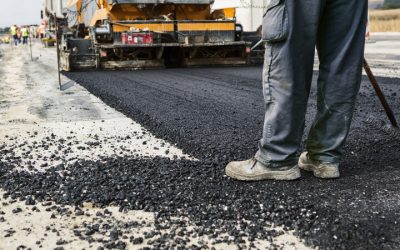Ever wonder how those smooth, black surfaces you drive on every day come to be? Whether it’s a commercial parking lot, a residential driveway, or a municipal road, professional asphalt paving is a fascinating process that combines engineering precision with specialized equipment and materials. But how does asphalt paving work exactly?
Unlike DIY home improvement projects, professional asphalt paving requires extensive knowledge, experience, and equipment to ensure long-lasting, high-quality results. At ALK Asphalt, with over 60 years of combined experience serving the Phoenix metro area, we’ve perfected this process to deliver superior results for both commercial and residential clients.
In this behind-the-scenes look, we’ll walk you through the entire asphalt paving process from initial planning to the finished product, giving you insight into why professional installation makes all the difference.
The Planning and Preparation Phase
Every successful asphalt paving project begins long before any equipment arrives on site. The planning and preparation phase is critical to ensuring the final pavement will stand the test of time.
First, experienced asphalt contractors conduct a thorough site assessment to evaluate existing conditions. This includes:
- Analyzing soil composition and stability
- Identifying drainage patterns and potential water issues
- Assessing traffic loads and usage requirements
- Measuring the area precisely to determine material quantities
Based on this assessment, detailed project specifications are created, including the appropriate asphalt mix design, thickness requirements, and construction methods. For commercial projects, these specifications often need to meet strict municipal codes and industry standards.
Proper drainage planning is particularly crucial—even the highest quality asphalt will deteriorate quickly if water cannot properly flow away from the surface. Skilled contractors design subtle slopes and drainage features to prevent water pooling and subsequent damage.
Before any work begins, necessary permits must be obtained, and in many cases, especially for commercial projects, traffic management plans need to be established to minimize disruption during construction.
Learn more about our experienced team at ALK Asphalt
The Removal and Excavation Process
When replacing existing pavement, the first step in the physical work is removing the old, damaged asphalt. This isn’t as simple as just tearing it up—professional contractors use specialized equipment to carefully remove the existing surface without damaging underlying utilities or adjacent structures.
The removal process typically involves:
- Using milling machines to grind away the existing asphalt to a predetermined depth
- Loading and properly disposing of the old asphalt material (which can often be recycled)
- Inspecting the exposed subgrade for any previously hidden issues
Once the old surface is removed, excavation begins to prepare for the new pavement structure. The depth of excavation depends on the project specifications and intended use of the finished surface. For example, commercial parking lots that will handle heavy vehicles require deeper excavation than residential driveways.
The excavation depth is not arbitrary—it’s carefully calculated to accommodate both the base materials and the asphalt layers while maintaining proper elevation relationships with existing structures like curbs and drainage inlets.
After excavation, the subgrade (native soil) is carefully graded and compacted to provide a solid foundation for the new pavement structure. Any soft or unstable areas discovered during this process are remediated to prevent future settlement issues.
Learn more about our professional removal services
The Base Layer Foundation
The quality of what lies beneath your asphalt is just as important as the asphalt itself—perhaps even more so. The base layer is the foundation upon which everything else depends, and cutting corners here leads to premature failure.
Professional asphalt contractors typically install a base layer consisting of:
- Aggregate base course (crushed stone or gravel)
- Geotextile fabrics (in areas with poor soil conditions)
- Stabilization materials (when necessary)
The aggregate base material is carefully selected for its ability to:
- Distribute loads from the surface to the subgrade
- Provide drainage for any water that might penetrate the asphalt
- Resist frost heave in colder climates
- Maintain stability under varying moisture conditions
Once placed, the base material is graded to create the planned surface contours and then compacted in layers using heavy equipment like vibratory rollers. Modern contractors use precision equipment guided by laser or GPS technology to achieve exact elevations and slopes.
Proper compaction is absolutely critical—experienced operators make multiple passes with compaction equipment, constantly checking density to ensure the base will not settle after the asphalt is applied.
Quality control testing during this phase might include density tests, moisture content analysis, and proof-rolling to identify any soft areas before proceeding to the next phase.
Discover our asphalt milling services
The Asphalt Application Process
Now comes the part most people associate with asphalt paving—the application of the hot mix asphalt itself. This process must be precisely coordinated and executed quickly while the material is at the optimal temperature.
Hot mix asphalt is produced at specialized plants where aggregates (crushed stone, sand, and gravel) are mixed with liquid asphalt cement at temperatures around 300°F. This mixture is delivered to the job site in insulated trucks to maintain its temperature.
Upon arrival, the asphalt is transferred to a paving machine, which:
- Spreads the material evenly across the prepared base
- Creates a uniform thickness according to specifications
- Forms the initial compaction of the material
Behind the paver, skilled operators use large rollers to compact the hot asphalt while it’s still pliable. This compaction is done in a specific pattern to ensure uniform density throughout the pavement.
Temperature management is critical during this phase—if the asphalt cools too much before proper compaction, the pavement won’t achieve its designed strength and durability.
For larger projects, multiple “lifts” or layers of asphalt are often applied. The bottom “base course” provides strength, while the top “wearing course” offers a smooth, durable surface. Each lift must be properly bonded to the one below it through the application of tack coats—a thin layer of liquid asphalt that ensures the layers function as a unified structure.
View our gallery of completed asphalt projects
Finishing Touches and Quality Control
The final steps in the asphalt paving process involve careful attention to detail and quality control measures that distinguish professional work from amateur efforts.
After final compaction, experienced contractors inspect all seams where separate passes of the paving machine meet. These areas require special attention to ensure they are properly bonded and won’t become weak points in the future.
Smoothness testing is often performed using straightedges or more advanced electronic profiling equipment to verify the surface meets specified tolerances. Proper drainage is confirmed by checking that water flows as designed to collection points without pooling on the pavement.
The newly installed asphalt needs time to cure and harden before it can handle full traffic loads. Professional contractors often use temporary markings and barricades to protect the fresh pavement during this critical period.
Before the project is considered complete, a final inspection checks for any imperfections or issues that need to be addressed. This attention to detail ensures the finished product not only looks great but will perform as designed for years to come.
Maintenance and Repair
Even the best-installed asphalt pavement requires ongoing maintenance to achieve its full potential lifespan. Professional asphalt contractors typically provide guidance on maintenance schedules and practices, such as:
- Sealcoating every 2-3 years to protect from oxidation and UV damage
- Crack sealing to prevent water infiltration
- Prompt repair of any developing issues before they expand
When damage does occur, professional patching techniques can restore both functionality and appearance. Rather than simply filling holes, quality repair work involves cutting out damaged sections, rebuilding the base if necessary, and installing new asphalt that bonds properly with the surrounding pavement.
Proper maintenance can more than double the lifespan of asphalt pavement, making it one of the most cost-effective investments for property owners.
Learn about our professional patching services
Trust the Professionals for Your Asphalt Paving Needs
As you can see, professional asphalt paving is a complex, multi-step process that requires specialized equipment, materials, and expertise. While the visible portion—the black, smooth surface—may seem simple, achieving a durable, long-lasting result demands attention to every detail from planning through completion.
For commercial property owners in Phoenix and Sun City, AZ, choosing an experienced asphalt contractor like ALK Asphalt ensures your pavement will be properly designed, installed, and finished to provide years of reliable service. Our team brings over 60 years of combined experience to every project, large or small.
Ready to discuss your commercial or residential asphalt paving project? Contact ALK Asphalt today at (602) 218-4997 for a consultation and free estimate. Let us show you the difference professional asphalt paving makes!



